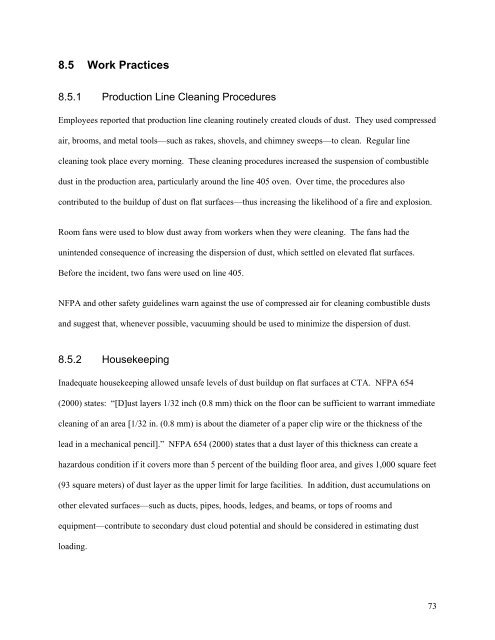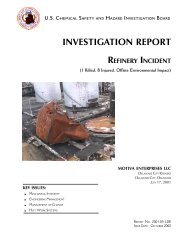CTA Report, Draft 1, ISP Review - US Chemical Safety and Hazard ...
CTA Report, Draft 1, ISP Review - US Chemical Safety and Hazard ...
CTA Report, Draft 1, ISP Review - US Chemical Safety and Hazard ...
Create successful ePaper yourself
Turn your PDF publications into a flip-book with our unique Google optimized e-Paper software.
8.5 Work Practices<br />
8.5.1 Production Line Cleaning Procedures<br />
Employees reported that production line cleaning routinely created clouds of dust. They used compressed<br />
air, brooms, <strong>and</strong> metal tools—such as rakes, shovels, <strong>and</strong> chimney sweeps—to clean. Regular line<br />
cleaning took place every morning. These cleaning procedures increased the suspension of combustible<br />
dust in the production area, particularly around the line 405 oven. Over time, the procedures also<br />
contributed to the buildup of dust on flat surfaces—thus increasing the likelihood of a fire <strong>and</strong> explosion.<br />
Room fans were used to blow dust away from workers when they were cleaning. The fans had the<br />
unintended consequence of increasing the dispersion of dust, which settled on elevated flat surfaces.<br />
Before the incident, two fans were used on line 405.<br />
NFPA <strong>and</strong> other safety guidelines warn against the use of compressed air for cleaning combustible dusts<br />
<strong>and</strong> suggest that, whenever possible, vacuuming should be used to minimize the dispersion of dust.<br />
8.5.2 Housekeeping<br />
Inadequate housekeeping allowed unsafe levels of dust buildup on flat surfaces at <strong>CTA</strong>. NFPA 654<br />
(2000) states: “[D]ust layers 1/32 inch (0.8 mm) thick on the floor can be sufficient to warrant immediate<br />
cleaning of an area [1/32 in. (0.8 mm) is about the diameter of a paper clip wire or the thickness of the<br />
lead in a mechanical pencil].” NFPA 654 (2000) states that a dust layer of this thickness can create a<br />
hazardous condition if it covers more than 5 percent of the building floor area, <strong>and</strong> gives 1,000 square feet<br />
(93 square meters) of dust layer as the upper limit for large facilities. In addition, dust accumulations on<br />
other elevated surfaces—such as ducts, pipes, hoods, ledges, <strong>and</strong> beams, or tops of rooms <strong>and</strong><br />
equipment—contribute to secondary dust cloud potential <strong>and</strong> should be considered in estimating dust<br />
loading.<br />
73









